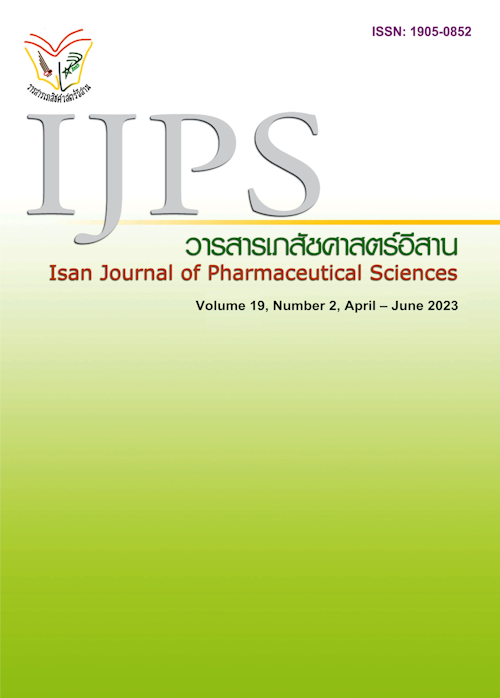การศึกษาคุณค่าทางโภชนาการและฤทธิ์ทางชีวภาพของข้าวพื้นเมืองไทย
Main Article Content
บทคัดย่อ
ข้าวพื้นเมือง (Oryza sativa L.) คือ ข้าวสายพันธุ์ดั้งเดิมที่มีการปลูกในท้องถิ่น แต่ยังขาดข้อมูลคุณค่าทางโภชนาการของข้าว และงานวิจัยสนับสนุนการนำไปใช้ประโยชน์ได้มากกว่าการรับประทาน วัตถุประสงค์: เพื่อศึกษาคุณค่าทางโภชนาการและสารออกฤทธิ์ทางชีวภาพที่สำคัญในข้าวพื้นเมือง จำนวน 9 สายพันธุ์ และศึกษาผลของตัวทำละลายในการสกัดต่อปริมาณสารออกฤทธิ์ วิธีการศึกษา: ศึกษาปริมาณสารฟีนอลิกรวมและฤทธิ์การต้านอนุมูลอิสระด้วยวิธี DPPH ในข้าวพื้นเมือง และคัดเลือกข้าวสองสายพันธุ์ไปแช่สกัดด้วยตัวทำละลายชนิดต่างๆ ได้แก่ น้ำกลั่น, 50% เอทานอล, 50% เอทานอลผสมกรดไฮโดรคลอริค 0.1% และ 99% เอทานอล และศึกษาฤทธิ์การต้านอนุมูลอิสระ ฤทธิ์ยับยั้งเอนไซม์ไทโรซิเนส รวมถึงความปลอดภัยของสารสกัดต่อเซลล์เคอราติโนไซต์ ผลการวิจัย: ข้าวทั้ง 9 สายพันธุ์มีคุณค่าทางโภชนาการสูงในด้านสารอาหารที่เป็นส่วนประกอบ ได้แก่ คาร์โบไฮเดรต โปรตีน ไขมันและเยื่อใยหยาบ และยังพบว่าข้าวเหล่านี้มีศักยภาพเป็นแหล่งเสริมแร่ธาตุที่จำเป็นหลายชนิด ได้แก่ ข้าวเหนียวดำม้งเป็นแหล่งเสริมแคลเซียม ข้าวเมล็ดฝ้ายเป็นแหล่งเสริมฟอสฟอรัสและทองแดง ข้าวทับทิมชุมแพเป็นแหล่งเสริมเหล็ก ผลการศึกษาพบว่า การสกัดข้าวเหนียวดำม้งด้วยตัวทำละลาย 50% เอทานอลในสภาวะกรดให้ปริมาณฟีนอลิกรวม (629.27±6.56 mg GAE/g) ฟลาโวนอยด์รวม (463.59±0.83 mg CE/g) แอนโทไซยานินรวม (517.10±9.49 mg/100g) และปริมาณสาร Cyanidin-3-O-glucoside สูงที่สุด (0.16 mg/g) ซึ่งสอดคล้องกับฤทธิ์ต้านอนุมูลอิสระเมื่อทดสอบด้วยวิธี DPPH ซึ่งมีค่า IC50 เท่ากับ 19.25±0.05 µg/mL นอกจากนี้ยังมีความสามารถในการยับยั้งเอนไซม์ไทโรซิเนสในช่วงความเข้มข้น 0.125-100 µg/mL และไม่พบความเป็นพิษต่อเซลล์เคอราติโนไซต์ในช่วงความเข้มข้น 1-1000 µg/mL สรุปผลการวิจัย: ข้อมูลที่ได้จากการทดลองในครั้งนี้แสดงถึงศักยภาพของข้าวพื้นเมืองที่สามารถนำมาใช้เป็นส่วนประกอบในการพัฒนาผลิตภัณฑ์ที่อาจมีผลบวกต่อสุขภาพและเป็นส่วนประกอบในผลิตภัณฑ์เวชสำอาง นำไปสู่การเพิ่มมูลค่าวัตถุดิบและการขยายผลในเชิงพาณิชย์ต่อไป
Article Details

อนุญาตภายใต้เงื่อนไข Creative Commons Attribution-NonCommercial-NoDerivatives 4.0 International License.
กรณีที่ใช้บางส่วนจากผลงานของผู้อื่น ผู้นิพนธ์ต้อง ยืนยันว่าได้รับการอนุญาต (permission) ให้ใช้ผลงานบางส่วนจากผู้นิพนธ์ต้นฉบับ (Original author) เรียบร้อยแล้ว และต้องแนบเอกสารหลักฐาน ว่าได้รับการอนุญาต (permission) ประกอบมาด้วย
เอกสารอ้างอิง
Bureau of Nutrition, editors. Dietary reference intake for THAIS. Bangkok: A.V Progressive Limited Partnership Press; 2020.
Bae IY, An JS, Oh IK, Lee, HG. Optimized preparation of anthocyanin-rich extract from black rice and its effects on in vitro digestibility. Food Sci. Biotechnol 2017; 26(5): 1415–1422.
Finocchiaro F, Ferrari B, Gianinetti A. A study of biodiversity of flavonoid content in the rice caryopsis evidencing simultaneous accumulation of anthocyanins and proanthocyanidins in a black-grained genotype. J. Cereal Sci 2010; 51: 28-34.
Giusti MM, Wrolstad RE. Characterization and measurement of anthocyanins by UV-Visible spectroscopy. Curr. protoc. food anal. chem 2001; F1.2.1-F1.2.13.
Gong ES, Luo SJ, Li T, Liu CM, Zhang GW, Chen J, Zeng ZC, Liu RH. Phytochemical profiles and antioxidant activity of brown rice varieties. Food Chem 2017;227:432-443.
Goufo P, Trindade H. Rice antioxidants: phenolic acids, flavonoids, anthocyanins, pro-anthocyanidins,α-tocopherols, toco-trienols, γ-oryzanol, and phytic acid. Food Sci Nutr 2014; 2(2): 75-104.
Kitisin T, Saewan N, Luplertlop N. Potential anti-inflammatory and anti-oxidative properties of Thai colored-rice extracts. Plant Omics 2015; 8(1): 69-77.
Kolakul P and Sripanidkulchai B. Phytochemicals and anti-aging potentials of the extracts from Lagerstroemia speciosa and Lagerstroemia floribunda. Ind Crops Prod 2017; 109: 707–716.
Likhitwitayawuid K, Klongsiriwet C, Jongbunprasert V, Sritularak B, Wongseripipatana S. Flavones with Free Radical Scavenging Activity from Goniothalamus tenuifolius. Arch Pharm Res 2006; 29(3): 199-202.
Limtrakul P, Semmarath W, Mapoung S. Anthocyanins and Proanthocyanidins in Natural Pigmented Rice and Their Bioactivities. Phytochemicals in Human Health 2019. IntechOpen London; UK,
Maisuthisaku P, Changchub L. Effect of extraction on phenolic antioxidant of different Thai Rice (Oryza Sativa L.) genotypes. Int J Food Prop 2014; 17(4): 855-865.
Marto J, Neves A, Gonçalves LM, Pinto P, Almeida C, Simoes S. Rice Water: A traditional ingredient with anti-aging efficacy. Cosmetics 2018; 5(2): 1-12.
Mosmann T. Rapid colorimetric assay for cellular growth and survival: application to proliferation and cytotoxicity assays. J. Immunol. Methods 1983; 65: 55-63.
Nam SH, Choi SP, Kang MY, Koh HJ, Kozukue N, Friedman M. Antioxidative activities of bran extracts from twenty one pigmented rice cultivars. Food Chem 2006; 94: 613-620.
Pereira-Caro G, Cros G, Yokota T, Crozier A. Phytochemical profiles of black, red, brown, and white rice from the Camargue region of France. J Agric Food Chem 2013; 61(33): 7976-7986.
Posoongnoen S, Thummavongsa T. Some Chemical Compositions and Antioxidant Properties of Local Rice in Nakhon Ratchasima Province, Thailand. BUSCIJ 2018; 23(2): 971-984.
Rice family Thailand. (2017). Retrieved March 17, 2020, from https://www.thairicedb.com/rice-detail.php?id=10.
Sompong, R., Siebenhandl-Ehn, S., Linsberger-Martin, G., and Berghofer, E. Physicochemical and antioxidative properties of red and black rice varieties from Thailand, China and Sri Lanka. Food Chemistry 2011; 124(1): 132-140.
Sripanidkulchai B. and Fangkrathok N. Antioxidant, antimutagenic and antibacterial activities of extracts from Phyllanthus emblica branches. Songklanakarin J. Sci. Technol 2014; 36: 669–674.
Sripanidkulchaia B, Junlatat J, Tuntiyasawasdikul S, Fangkrathoka N, Sanitchon J, Chankaew S. Phytochemical and bioactivity investigation of Thai pigmented-upland rice: Dam-Mong and Ma-led-Fy varieties. Agr. Nat. Resour 2022; 56: 889-898.
Sueaman K, Pinwattana K, Paksee S, Arpsuwan A, Sam-ang P, Jannoey P, et al. Determination of antioxidant capacity of Riceberry and Khao dok mali 105 cultivars. PSRU J. Sci. Tech 2019; 4(3): 95–108.
Teeranachaideekul V, Wongrakpanich A, Leanpolchareanchai J, Thirapanmethee K, Sirichaovanichkarn C. Characterization, biological activities and safety evaluation of different varieties of Thai pigmented rice extracts for cosmetic applications. PSA 2018; 45(3): 140-153.
Vitchit W and Saewan N. Antioxidant and Anti-aging activities of callus culture from three rice varieties. Cosmetics 2022; 9: 79-94.
Vongchitpinyo S, Chotirotvakin C, Tongchitpakdee S. Effect of Extraction Solvents on Total Phenolics, Total Flavonoids, Total anthocyanins and radical scavenging properties in grape peels and seeds. Proceedings of 47th Kasetsart University Annual Conference: Agro-Industry, 2009 Mar 17-20; Bangkok, Thailand
Wasim AA, Naz S, Khan MN, Rehman SF. Assessment of heavy metals in rice using atomic absorption spectrophotometry-a study of different rice varieties in Pakistan. Pak. J. Anal. Environ.Chem 2019; 20 (1): 67-74.
Yodmanee S, Karrila TT, Pakdeechanuan P. Physical, chemical and antioxidant properties of pigmented rice grown in Southern Thailand. Int. Food Res. J 2011; 18(3): 901-906.
Zhao LJ., Liu W., Xiong SH, et al. Determination of total flavonoids contents and antioxidant activity of Ginkgo biloba leaf by near-infrared reflectance method. Int. J. Anal. Chem 2018: 8195784. doi.org/10.1155/2018/8195784.


